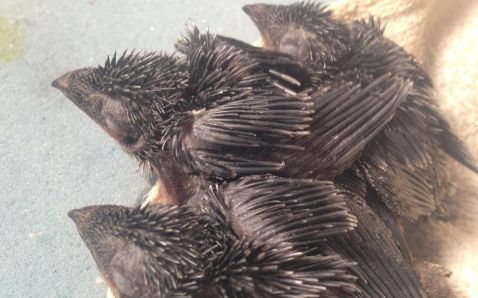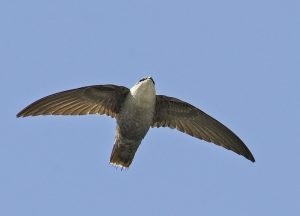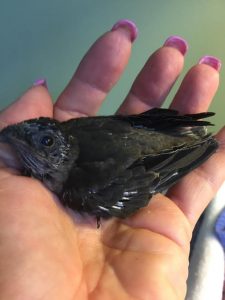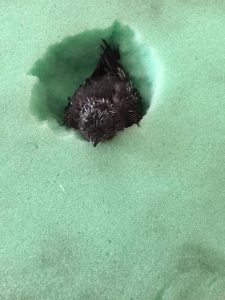
It’s summer, you’re in your house, and suddenly there’s a commotion. There’s a small tap, then a really fast chittering sound – as if a garden gnome has come to life and is furiously shaking a tiny pair of maracas. You rush over to investigate, and there are birds in your fireplace.
They’re Chimney Swifts.

Chimney Swifts are remarkable birds who are having a harder and harder time finding brick chimneys in which to nest and raise their families. Old factories and mills are being torn down, and they can’t use house chimneys which have been lined or capped. They return faithfully every year to their nest site, so if their chimney is suddenly unavailable, it’s a bad surprise. They eat enormous numbers of insects and their aerial ballets are stunningly beautiful, so they’re very good guests.
They eat on the wing, covering up to 500 miles a day in search of food, coming to rest only at night and clinging to vertical structures because they’re incapable of perching. Their nests are made of tiny twigs and stuck to the side of chimneys with their sticky saliva. They are among the most difficult birds for wildlife rehabilitators to raise, so if any fall down your chimney their best chance of survival is to put them back up there again. This may sound impossible, but it’s not.

Jayne Neville runs Mount Vernon Songbird Sanctuary in Southington, Connecticut, and is the area’s go-to guru when it comes to swifts and swallows. “There’s no nest left, Jayne!” I said into the phone recently, when I found myself on the receiving end of four nestling chimney swifts. The nest had broken into pieces when it hit the floor in a clothing shop in Cold Spring, New York; but luckily store owner Elise Gorman and her customer/friend Pat Campbell sprang into action, which was where I eventually came in.
“You don’t need the nest!” said Jayne. “You need thick foam! How fast can you get some?”
Jayne has given many presentations about rehabilitating Chimney Swifts; so here, straight from the source, is Chimney Swift Re-Nesting 101:

Make sure the babes are not cold. If they have been on the floor and away from their parents for any length of time (especially if they’re young and unfeathered) their body temperatures will have dropped, and they won’t survive without a rehabilitator. Carefully pick them up – they don’t bite, and just wash your hands with regular soap afterward – and make sure they are warmer than your hand. If not call a rehabber, who can warm them, hydrate them, feed them, then return them to the chimney and to their parents’ care.
If they are feathered and old enough to cling to the chimney wall, they can simply be placed back up the chimney. Monitor it for the sounds of the nestlings’ loud begging calls and the adults flying in and out. You can occasionally check them with a flashlight.
If they are warm and chattering but not fully feathered and their nest has been destroyed, you will need to buy a long piece of thick foam, the kind they sell for various crafts or to reupholster chairs. The goal is to create a platform, and the foam should be cut so it wedges so firmly up the chimney that the nestlings cannot fall down again. After you have fitted the foam to your chimney, pull it out and cut a hole in the middle – not all the way through, but enough to make a nest-like depression. Place the nestlings in their new “nest,” then very, very carefully wedge the foam up the chimney, having first made certain the parents have a clear path to helicopter their way down the chimney and reach their offspring.

You’ll need to keep both an eye and an ear on things – watch to make sure the adults are still going in and out, and listen for the nestlings’ chattering cries. Chimney Swifts are dedicated, hard-working parents, and will not abandon their nestlings unless they think they’re gone for good. It’s always better to be in contact with a wildlife rehabilitator during this process, as they can answer any questions that come up.
These fabulous birds fly all the way to South America for the winter, then return in the spring. How great to be able to turn a potential swift family disaster into a success!
Many thanks to Jayne Neville for her expertise. Donations to her songbird conservation organization are tax-deductible …
Mount Vernon Songbird Sanctuary
1024 Mt. Vernon Road
Southington, CT 06489
jayne@mvssanctuary.org
www.mvssanctuary.org
Banner photo by Suzie Gilbert; first photo by animalia-life.com; third and fourth photos by Jayne Neville.











One of my all-time favorite birds … I am so blessed that our large apartment complex is their home during the warm months. I love watching them and hearing their gleeful chittering morning and evening, and am thankful they vacuum up so many bugs. The day I realize they’re gone for the winter is always a sad one. Thank you and your colleagues for helping to save them, Susie!
Love that you appreciate them so much, Meredith!
I have 4 chimney swift baby birds in my outdoor fireplace clung to the side of the wall. Their nest fell. The parents have been in and out flapping around in the fireplace and the babies are chirping loudly intermittently. They are small but have feathers and their eyes are open. The way our outdoor fireplace is set up, it’s about a 2 story chimney straight up and out. I talked to the local rescue and they said leave them alone and monitor. Should I be doing something else? I can’t access the chimney area as high as they were… thank you! Worried about them
Take what is left of the nest and place it in a berry basket, or something similar – any kind of container with holes in the bottom so if it rains the water will drain through – and put what’s left of the nest and the babies in it. You can add very small twigs or grass, but don’t use man-made materials (their claws can become ensnared). I don’t know how big the fireplace is, but try rigging a small platform inside it so you can place the nest on top of it and as far up the chimney as you can get them. Even six inches will do – you just want them to have some protection and not be exposed. The parents will do the rest. Thanks for your concern for them! I hope it works.
Note: Answer provided to me by a wildlife rehabilitator.